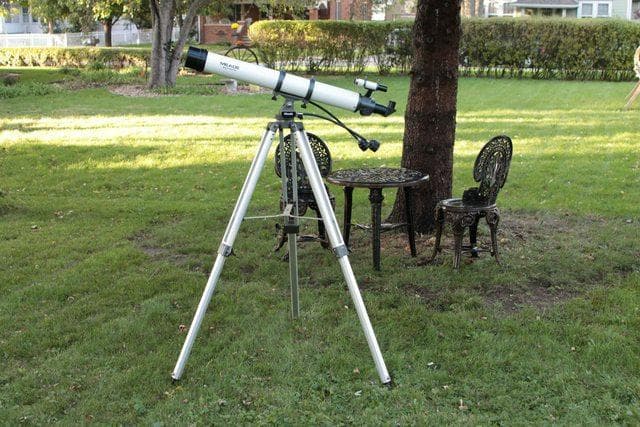
with David Fuller

A Meade 390 refractor gets resuscitated
As we age, many of the hardships or poor experiences fade in one's memory, and we often see the past through rose-colored glasses. This can have the effect of making us long for what we fondly remember as simpler, easier times, when life was always better.
Of course, this usually isn't true. But some things really do retain their luster and value over time. An example of that is the telescopes made many decades ago. At the time, they were often prohibitively expensive for amateur astronomers, and one instrument's purchase meant saving up for many months or even years. These days, these scopes can be found in the garages and basements of many a home, neglected, dusty, or dragged out only for the occasional, spectacular astronomical event such as a bright comet. This is too bad, because many of these instruments are superior in many ways to presently available telescopes.
An example, you ask? But of course! How about this?

At first glance, it looks pretty nice, right? This is a Meade 390 refractor telescope, mounted on an altitude/azimuth mount (up/down - spins around). So it doesn't follow the stars in the sky when viewing, but was sold more as a terrestrial scope that could also be used for casual stargazing.
FULL CONFESSION: I totally lusted after this scope in the 1990's! After I purchased my very first "real" telescope - a 50mm f/10 Meade refractor with 0.965" eyepieces on an alt-az mount - I delved into researching what a "better" telescope would be. I scoured the ads in Astronomy magazine for hours, looking at the fantastic Meade and Celestron offerings, along with Coulter Optical Dobs and such. Although I eventually settled on a "This will be the last telescope I will ever have to buy" Celestron C8+ Schmidt-Cassegrain telescope (I sold it a few years ago), I still always wanted a 90mm, long-focal length refractor.
A couple years ago, Orion Telescopes was selling a 90mm f/10 white-tube refractor, just the optical tube assembly - and, it was on sale! I jumped at it - I finally had my 90mm scope! Though it still wasn't a Meade. The views in the 90mm are what expected - showed a lot for a refractor, and the chromatic aberration, while visible, was somewhat tolerable.
But a few weeks ago, I saw this Meade 390 on an online auction. It appeared to have some issues, but I wound up getting it for a mere $20! It's hard to beat that for a scope one has wanted for a long period of time. When it arrived, I discovered it really did have a few problems. Chief among them was a completely missing dew cap:

Not ideal, of course, but dew caps can be made from easily available aluminum tubing sources... or so I thought.
Turns out... not so much!
It is really, REALLY hard to find 4" ID aluminum tubing that is also thin-wall. The only thing I could find was 4" ID and 4.5" OD. I really didn't want to have a .25" wall thickness for my telescope's dew shield, as there's already enough weight on that end of the scope from the lens glass.
I wasn't worried though - dew shields need not be aluminum. They can be made from paper or foam or... well, most anything really. I knew I'd find something.
Another issue with the scope was the finder though. I could see in the original auction photos that something appeared to be wrong with the finderscope, but given that they are small and often easily fixed or replaced, I wasn't worried about that either. Here's what I actually got with the finder:

Yes, that is a completely missing finderscope lens AND dewshield assembly. It's just an open tube at the front. The eyepiece lens is there on the other side, but the main lens end? WIDE OPEN.
Hmmm...
Okay, not a problem. I had an extra 6x26 finderscope from Orion lying around, and simply swapped it out. It was a black one, so again, not ideal, but it worked.
Note on the finderscope mounting rings how there are also some locking nuts inside the thumbscrews. I actually like this set up. Once the finderscope is aligned with the main tube, it can be "set" in place and is less likely to be knocked out of alignment over time.
Again, minor issue, and easily fixed.
A bigger issue was the lens itself. DUSTY! And not just dusty, but very dirty and looked as if it had been left wide open in... I don't know, a barn or something. Check out the "before" picture of the lens in it's cell:

Yes, it was bad. I tried to remove the lens retaining ring. It was STUCK on there, and good. A gentle fingernail produced no movement. A very careful use of a screwdriver blade produced... no movement. A "made to avoid scratching the lens" spanner wrench from a piece of wood and some heavy nails produced... well, a few scratches on the lens cell (oops!), but still no movement on the retaining ring.
Apparently, the glass for this lens was NOT going to come out of the cell!
Okay, Plan B! Clean the lens IN the cell! I carefully blew off the dirt that was loose. Then I carefully, using a soft brush, removed the semi-loose dirt. You know how much those two processes removed? Almost NOTHING.
This lens was DIR-TY. Big time. Since lenses are different than telescope mirrors, and can handle a bit harsher treatment, I decided it needed a bit more aggressive -if still careful - work. Using rubbing alcohol and LOTS of cotton balls, I carefully scrubbed as much dirt off the lens as I could, swapping cotton balls frequently to avoid scratching the glass as the cotton picked up dirt. Here's the "after" picture of the cleaned lens-in-cell:

Not half bad (except for that yucky-looking blob of stuff on the front side that would NOT come off not matter WHAT I did!). There were some other easily-corrected problems, like a truly terrible star diagonal that looked like the mirror had been used by spiders for a nest, and some scuffs and marks on the scope, but none of these really mattered to me. What mattered was, "How do images LOOK at the eyepiece!"
I got my answer a few nights later when it cleared (you've heard of the Astronomer's Curse, right? That's when it gets cloudy for days on end after you receive new equipment). Anyway, the Moon looked fantastic, even though it was very, VERY full when I looked at it. What impressed me even more though, was that I could see the Saturn Nebula (NGC7009) even WITH that full Moon shining down on me! The clouds rolled in not long after that, so it was a short session, but here's what impressed me:
Almost NO chromatic aberration on the Moon. Could it be the slightly longer focal length of 1000mm compared to the Orion's 900mm made all the difference? I'm not sure, and I'll have to compare both with the same eyepieces some time to find out. But this is an impressive old scope. Oh, and what else is great? When you post about old telescopes like this in the Classic Telescopes forum at Cloudy Nights, you very often get incredibly generous help from people. A contributor to that site saw my post and pictures, and sent me a message saying he has a Meade 395 scope that has a chipped lens, but a good finderscope and dew shield. He sold it to me for a very reasonable price. I also found in the Classifieds there someone who was selling the Meade 395 equatorial mount for this scome, so I'll be able to make a more complete Meade refractor - just like the one I wanted 20 years ago.
Those items haven't arrived yet, but I'll post more about them when received.
